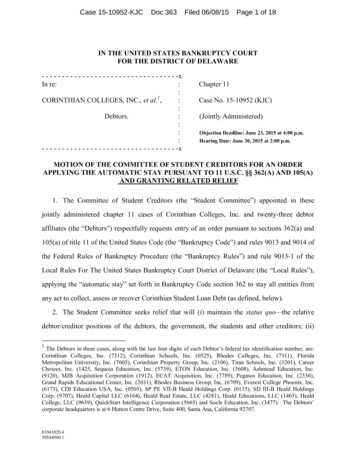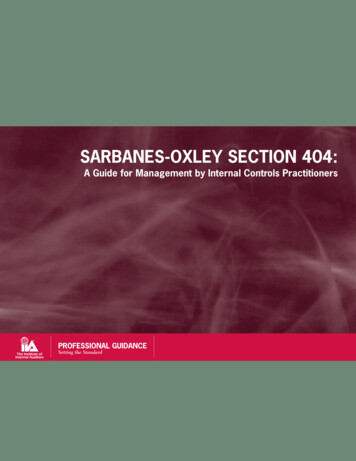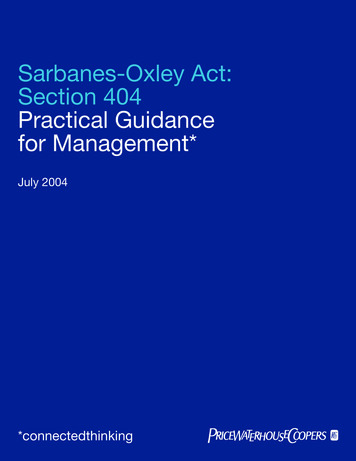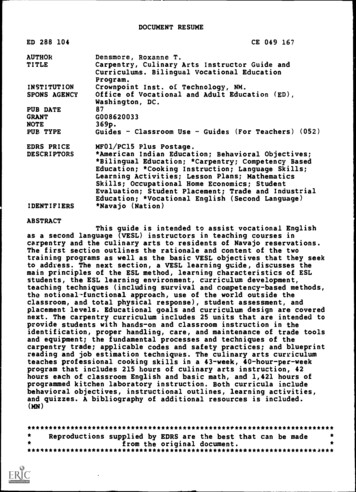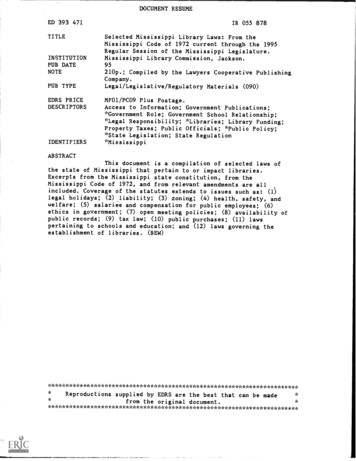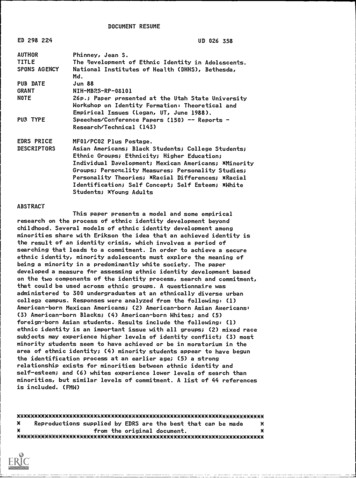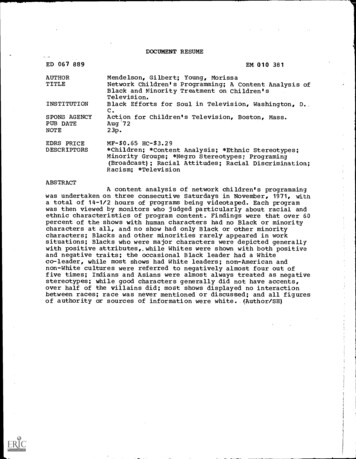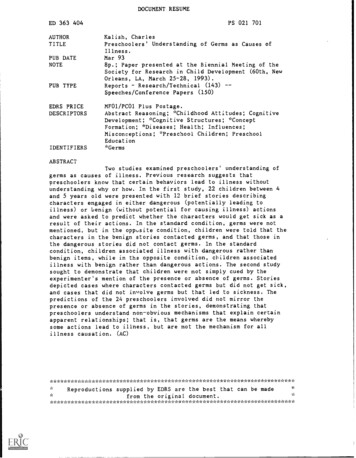
Transcription
DOCUMENT RESUMEPS 021 701ED 363 404AUTHORTITLEKalish, CharlesPreschoolers' Understanding of Germs as Causes ofPUB DATENOTEMar 938p.; Paper presented at the Biennial Meeting of theSociety for Research in Child Development (60th, NewOrleans, LA, March 25-28, 1993).Research/Technical (143)ReportsSpeeches/Conference Papers (150)Illness.PUB TYPEEDRS PRICEDESCRIPTORSMF01/PC01 Plus Postage.Abstract Reasoning; *Childhood Attitudes; CognitiveDevelopment; *Cognitive Structures; *ConceptFormation; *Diseases; Health; Influences;Misconceptions; *Preschool Children; PreschoolEducationIDENTIFIERS*GermsABSTRACTTwo studies examined preschoolers' understanding ofgerms as causes of illness. Previous research suggests thatpreschoolers know that certain behaviors lead to illness withoutunderstanding why or how. In the first study, 22 children between 4and 5 years old were presented with 12 brief stories describingcharacters engaged in either dangerous (potentially leading toillness) or benign (without potential for causing illness) actionsand were asked to predict whether the characters would get sick as aresult of their actions. In the standard condition, germs were notmentioned, but in the oppvsite condition, children were told that thecharacters in the benign stories contacted germs, and that those inthe dangerous stories did not contact germs. In the standardcondition, children associated illness with dangerous rather thanbenign items, while in the opposite condition, children associatedillness with benign rather than dangerous actions. The second studysought to demonstrate that children were not simply cued by theexperimenter's mention of the presence or absence of germs. Storiesdepicted cases where characters contacted germs but did not get sick,and cases that did not involve germs but that led to sickness. Thepredictions of the 24 preschoolers involved did not mirror thepresence or absence of germs in the stories, demonstrating thatpreschoolers understand non-obvious mechanisms that explain certainapparent relationships; that is, that germs are the means wherebysome actions lead to illness, but are not the mechanism for allillness causation. **************************Reproductions supplied by EDRS are the best that can be made*from the original ******************************
U S DEPARTMENT Of EDUCATION000e of Educahonai Re3.91,Ch IMO 10,DrOvennIlinlE DUCA noNAL RESOURCES INFORMATIONCE NTERTrPreschoolers' Understanding of Germsas Causes of Illnessth,s clOC ument has Clain rptolucts0 at'eCenvea horn the person or organolstionOriginalolg .1ereC7 Minor changes Race Dean mag to wnpion,eo,ocloclon qualityRoin15 Of c.e,or 0 oprit0n Silted 11 10,5 CIOCu.m/101 ao not necessanty represent offIcralCharles KalishUniversity of MichiganPERMISSION TO REPRODUCE THISMAI ERIAI HAS BEEN GRANTED BYOE RI oos.t.on Or 001CyPresented at SRCD, New Orleans, March, 1993TO THE EDUCATIONAL RESOURCESINFORMATION CENTER ERICIAbstractTwo studies examine preschoolers' understanding of a particular non-observablestudies, preschoolerscausal mechanism; germs as causes of illness. According to existingidea why or how. From an adultknow that certain behaviors lead to illnpsc hut have noYet doperspective, many of the behaviors children recognize involve contact with germs.the mechanismschildren understand that germs (non-obvious, invisible particles) aredemonstrates that 4involved in some cases of illness causation? The first study presentedcontagion areand 5-year-olds' predictions of who will get sick in cases of contamination andcontrol and further, tests howbased on the presenceiabsence of germs. Study 2 serves as achildren think are mediated v germs?children generalize this mechanism; which causes dothe role of germs.Data suggest that preschoolers understand but under-generalizeIntroductionyoung childrenRecent work in cognitive development suggests that even very& Gelman, 1992organize their knowledge of the world into naive-theories (see Wellmanaboutfor review). An important component of naive theories are hypotheses(Gopnikunobservable entities which act as underlying mechanisms in causal interactionsthe actual& Wellman, in press). To date, however, researchers have not describedknow about. The present stndies take up the question ofmechanismsorentitieschildrenk.vimportant and salient case ofwhether preschool-aged children understand onemechanism; the role of germs in causing illness.to illnessExisting accounts argue that preschoolers can identify behaviors leading(see Burbach & Peterson, 1986 forbut do not understand the underlying mechanismsmechanism,review). Specifically, the concept of germs, or any other non-obvious causaladdress two questions;ef!), has been thought to be beyond children's grasp. The present studiesas causes of illness and, if so, which behaviors aref4)--214 do children ever recognize germsthought to involve germs as mechanisms?that youngSome studies of illness (e.g., Keil, 1991, Springer & Ruckel, 1993) suggestproposed to them.children may recognize the role of germs when the possibility is directly2
KalishUnderstanding of GermsThese studies, however, have not specifically asked whether, or in what cases, children seegerms as mechanisms of illness. Further, studies of spontaneous explanations continue toshow that preschoolers do not know what germs are or what they do (Banks, 1990).Study 1Study 1 investigated whether children recognize germs as the mechanismunderlying two familiar causes of illness (contagion and contamination).The traditional hypothesis is that children understand causes of illness as simplebehavioral rules (e.g., get sick if you eat food from the garbage); they know actionsassociated with illness.A first alternative is that children recognize germs as another feature associatedwith illness. Just as they have learned to associate being around sick people with illness, sohave they learned to associate germs with illness.A second possibility is that gernis are seen as the mechanism underlying orexplaining ,some observed associates of illness. For example, contamination and contagionmay be causes of illness only via the operation of germs; germs mediate in these cases.MethodsFour- and 5-year-olds (N 22, Mean Age, 4:10) were presented with twelve briefstories describing characters engaged in some actions. Children were asked to predictwhether the characters would get sick or not as a result of these actions.Two types of stories were presented. (See Figure la)Six Dangerous stories described actions which might be thought to lead to illness.Six stories were Benign, involving action which wouldn't seem likely to lead toillness.Stories were presented in one of two conditions (11 Subjects/ condition).In the Standard condition, germs were not mentioned.For the Opposite condition, children were told that characters contacted germs inBenign stories, and that no germs were contacted in Dangerous stories.PredictionsIf children just know behavioral correlates of illness, information about germsshouldn't effect their responses. Responses in the Standard and Opposite conditions willbe the same.If children see germs as just another associate of illness, the opposite condition willpose a problem; one set of associations predict illness, another set predict no illness. Facedwith this conflict, children should respond randomly.32
Understanding of GermsKalish3Finally, if children view germs as the mechanisms underlying other causes ofillness, the pattern of responses in the two conditions should be exactly opposite. It's thepresence or absence of germs that predicts illness, not some associated conditions.(See Figure 2a)ResultsDangerous Items:Were said to cause illness in the Standard condition (M .97 Sdev.07 p. .01, t or signtest).Were not seen as causes of illness in the Opposite condition (M .25 Sdev. .14t or sign test).Benign Items:t or sign test).Did not cause illness in the Standard condition (M .32 Sdev. .23Did in the Opposite condition (M .89 Sdev. .20 R. .01, t or sign test).In an ANOVA, the interaction between Condition and Story-type was significant (F(1, 18) 80.3, MSE .05, px.0001), while main effects of these variables were not.DiscussionThese results suggest that preschoolers see germs as the mechanisms underlyingsome causes of illness. Existing research has shown that children understandcontamination and contagion as two causes of illness. These new findings argue that it isnot direct features of a situation that make an instance of contagion or contamination (e.g.,contagion does not equal proximity to sick people). Rather, it is some underlying processthat makes these conditions potent causes illness. At least some cases, germs are necessaryfor contamination or contagion.An alternative explanation, though, is that children were responding to taskdemands of the procedure. Subjects may have inferred that the experimenter wantedthem to associate germs with illness; why else would germs be mentioned unless theywere relevant to predictions of illness? A second study tested whether children were usinga simple response strategy.Study 2Study 2 serves as a control and extension of Study 1. It was designed to demonstratethat children were not simply being cued by the experimenter's mention of the presence orabsence of some unknown entity. Items were chosen to depict cases where characterscontact germs but would not get sick, as well as cases that don't involve germs but do leadto sickness.This second study was also useful as a test of a possible way children mightunderstand the concept of illness. If germs are the mechanism for some illness, perhaps4
KaiishUnderstanding of Germsthey are responsible for all illness. Children might hold a "germ theory" of illness.Several researchers have suggested that children think that all illness is contagious (Nagy,1954; Brewster, 1982; Hergenrather & Rabinowitz, 1991; Kister and Patteison, 1980). Ifgerms are the mechanisms for contagion, then all illness would involve germs.MethodAgain in this study, children were asked to predict whether characters in a set ofstories would get sick or not. (See Figure lb) Twenty-four 4- and 5-year olds participated inthis study (Mean Age, 4:11; 12 per condition).Benign stories differed in the two conditions. In the Standard condition, they justdescribed simple actions. In the Opposite condition these items described characterscoming into contact with germs, but not in ways that we typically think of as leadingto illnessDangerous stories involved causes of illness other than contamination or contagion.These items were based on studies of children's spontaneous reports of illnesscauses. For these items the issue was whether they would continue to be seen ascauses of illness even in the absence of germs.(See Figure 2b)ResultsBenign items:Were not seen as causes of illness; predictions were below chance in both theStandard and Opposite conditions (Standard M. 0, Stdev 0; Opposite M .12, Stdev .13, p, .01, t or sign-test).Dangerous items:Predictions of illness were above chance in both conditions. (Standard M .92, Stdev .11; Opposite M .83, Stdev .12, p, 01, t or sign-test).There was a significant difference in the mean proportion of illness predictionsbetween the two conditions (Wilcoxon Signed Ranks, z 1.9, R .05).The difference in the means did not hold for individual items. In no case did theabsence of germs lead to significantly lower predictions of illness for a Dangerousitem. Post hoc tests on the three largest differences revealed none of them to besignifican (Largest Chi-square 3.4 (1 d.f.), n.s.).DiscussionIn Study 2, children's predictions did not mirror the presence or absence of germs inthe stories. This suggests that performance in Study 1 was not due to task demands.Preschoolers understand that some conditions can cause illness even in the absenceof germs. These children do not seem to hold a germ theory of illness; illness is notdefined by the action of germs.4
KalishUnderstanding of Germs5Chilaren's understanding of germs may be restricted to a subset of those casesrecognized by adults. Adult intuitions would seem to be that a number of the Dangerousitems in Study 2 would not cause illness in the absence of germs. Children, however, didnot see absence of germs as significant for any of the items.ConclusionsChildren's understanding of the causes of illness is not limited to simplegeneralizations about relationships between observable entities. Neither is theirknowledge best described as simply a set of associations. Rather, preschoolers understandnon-obvious, mechanisms that underlie, or explain, certain apparent relationships.Germs are seen as the means whereby some actions lead to illness. However, germsare not the mechanism for all illness causation. Children recognize a variety of causes.Future research should determine how children understand germs and why they see themoperating in some cases but not others. This work would be part of a broader investigationof children's understanding of illness (e.g., what makes a condition an illness? what arethe consequences of illness?) and the relationship between illness beliefs and naivetheories.ReferencesBanks, E. (1990). Concepts of health and sickness of preschool and school-aged children.Children's Health Care, 19(1), 43-48.Burbach, D. J., & Peterson, L., (1986). Children's concepts of physical illness: A review andcritique of the cognitive-developmental literature. Health Psychology, 5(3), 307-325.Gopnik, A. & Wellman, H. M. (in press). The theory theory. in L. Hirschfeld & S. Gelman(eds.) Domain specificity in cognition and culture, New York: Cambridge UniversityPress.Hergenrather, J. R., & Rabinowitz, M., (1991). Age-related differences in the organization ofchildren's knowledge of illness. Developmental Psychology, 27(6), 952-959.Keil, F. C., (1991). The origins of an autonomous biology. Paper presented at the MinnesotaSymposium on Child Development, Minneapolis.Springer, K., & Ruckel, J. (1993). Early beliefs about the cause of illness: Evidence againstimmanent justice. Copitive Development, 1 429-443.Wellman, H. M. & Gelman, S. A. (1992). Cognitive development: Foundational theories of337-375.core domains. Annual Review of Psychology,6
Standud Condition.:No mention of germsBenignDangerousJimmy dropped his apple ina glass of water. He tookthe apple out of the waterand ate it.Julie dropped her apple inthe garbage. She took theapple out and ate it.appLaitrSaLdina LC nGerms in Benign storiesbut not in Dangerous storiesBenignDangerousJimmy dropped his apple ina glass of water. Germsgot all over the apple. Hetook the apple out of thewater and ate it.Julie dropped her apple inthe garbage. Nogennisgaton the apple. She took theapple out and ate it.Figure la: Examples of Stories from Study 1Standard Condition:Associations with IllnessBenignDangerousJulie went to thestore to buy somebread.Jimmy ate some soap.Jackie smoked a cigaretteOpposite Condition:Germs in Benign storiesbut not in Dangerous storiesBenignJulie licked somecelery and got hergerms on it. ThenJulie ate the celery.Figure lb: Examples of Stories from Study 2DangerousJimmy ate some soap.There were no germson the soap.
Results: Study 1Proportion of "will get sick" site0 Dangerous ItemsBenign ItemsFigure 2aResults: Study 2Proportion of "will get sick" 00Standard0 Dangerous ItemsFigure 2bOppositeBenign Items
AUTHOR Kalish, Charles TITLE Preschoolers' Understanding of Germs as Causes of. Illness. PUB DATE Mar 93 NOTE 8p.; Paper presented at the Biennial Meeting of the. Society for Research in Child Development (60th, New Orleans, LA, March 25-28, 1993). PUB TYPE. Reports. Research/Technical (143)

